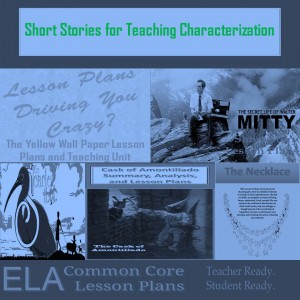If you’re busy, go ahead and download this word document and come back later to read this incredibly engaging blog post: Different Types of Characters in Literature.
I had just taught some great short stories for teaching theme and was feeling pretty good about life. I was feeling good enough, in fact, to put posters of myself up in the teacher’s lounge for my Teacher of the Year campaign.
And then I busted out a character analysis lesson plan from 1972. It was a dismal failure. 4 kids still have not come out of their boredom-induced coma. As punishment, I paid the custodian to rap my knuckles with a stapler until they bled. I passed out from the pain. When I woke up, Guy de Maupassant stood over me. He uttered something in French, which I did not understand, and handed me a literary character analysis lesson plan.
I now share it with you.
Literary Character Analysis Lesson Plan Instructions

We’re gonna characterize these characterization lesson plan by calling them dynamic and engaging. The short stories for teaching characterization bundle contains complete short story units for the following: “The Scarlet Ibis” by James Hurst “The Secret Life of Walter Mitty” by James Thurber “The Cask of Amontillado” by Edgar Allan Poe “The Necklace” by Guy de Maupassant “The Yellow Wallpaper” by Charlotte Perkins Gilman
As you read various short stories, you’ll want to talk about characterization and the different types of characters. For a list of short stories for teaching characterization, follow the link. Here’s what you need to cover.
- Protagonist
- Antagonist
- Major Characters
- Minor Characters
- Round Characters
- Flat Characters
- Dynamic Characters
- Static Characters
As you read short stories, discuss specific characters and how you would categorize them. Once you’ve read several stories, hand out the chart: Different Types of Characters in Literature Word doc. You’ll need to edit it for the specific short stories you’ve read. That should take you about 45 seconds. Other than that, it’s teacher-ready and student-ready.
ELA Standards
You might need some standards to show everyone how awesome the lesson is.
- RL.9-10.1 Cite strong and thorough textual evidence to support analysis of what the text says explicitly as well as inferences drawn from the text.
- RL.9-10.10 By the end of grade 9, read and comprehend literature, including stories, dramas, and poems, in the grades 9-10 text complexity band proficiently, with scaffolding as needed at the high end of the range. By the end of grade 10, read and comprehend literature, including stories, dramas, and poems, at the high end of the grades 9-10 text complexity band independently and proficiently.
- RL.9-10.3 Analyze how complex characters (e.g., those with multiple or conflicting motivations) develop over the course of a text, interact with other characters, and advance the plot or develop the theme.
Teaching Literary Elements with Short Stories
Understanding literary elements is necessary for literary analysis. These short stories will help you teach literary elements.
- The Best American Short Stories
- Short Stories for Teaching Theme
- Short Stories for Teaching Irony
- Short Stories for Teaching Symbolism
- Short Stories for Teaching Conflict
- Short Stories for Teaching Foreshadowing
- Short Stories for Teaching Imagery
- Short Stories for Teaching Characterization
